Toggle Background Color


The Mission
We open to a man strapped to a chair, needled and questioned by disembodied voices about numbers and some crazy Russian literally named after dragons. The only way to get to the bottom of this is basically going over the last ten years of the man's life.
The important bits begin in the middle of April of 1961...
The History
This mission sets the standard for the game of holding hands with well-known incidents from the 60s. As such, we begin by taking part in the infamous Bay of Pigs invasion, the attempt to overthrow Fidel Castro's government in Cuba after they cut ties with the US and forged economic links with the Soviet Union instead.
The plan initially got rolling in March 1960, where President Eisenhower gave the CIA the go-ahead to begin planning, solidifying itself that August when he secured thirteen million dollars for the CIA to use. The main players in the actual invasion, however, were Brigade 2506, a CIA-sponsored paramilitary group composed of Cuban exiles who had come to the States after Castro came to power. The brigade ultimately composed of just shy of 1,400 men, divided into five infantry battalions and one paratrooper battalion, all of whom set out from Guatemala for Cuba on April 13th, 1961, also getting support from a flight of eight B-26 bombers.
The real battle began on the night of April 16th, when the brigade landed at the Playa Girón beach in the Bay of Pigs, overwhelming a local militia and moving on from there. Things quickly turned sour for the simple fact that everybody knew that the US had backed and financed them, and to avoid any further stigma President Kennedy declined to provide further air support for the invasion. This left it with about half the forces the CIA had felt would have been necessary to successfully topple Castro's government. On the 20th, Brigade 2506 formally surrendered; of the 1,334 men that had made the trip from Guatemala to the Bay of Pigs, 114 drowned in landing attempts or were killed fighting government troops, and 1,183 were captured and imprisoned. Those prisoners were eventually freed thanks in part to private sympathizers in the US who negotiated to trade fifty-three million dollars worth of food and medicine to Cuba in exchange for their release, the actual transfer happening between December 23rd and 29th of 1962. Some of the brigade's veterans went on to found the Brigade 2506 Veteran's Association, which today owns the Bay of Pigs Museum & Library in Miami, Florida.
The Weapons
Yes, I'm still going to be doing this sort of thing, don't worry.
Our starting loadout consists of the ASP pistol and M16 assault rifle, both solid and dependable weapons, the latter especially thanks to the attachment of an M203 grenade launcher.

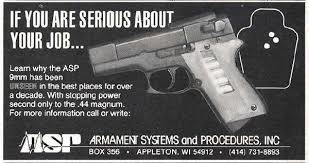
Image source: ASP9 advertisement, Guns.com
The ASP is heavily based on Smith & Wesson's Model 39 pistol, the first indigenous double-action semi-auto pistol marketed in the United States, with modifications made for use with special forces including a smaller, rounded hammer, a shortened slide and barrel, clear polycarbonate grip panels and open-sided magazines for visually confirming ammo count, and a unique "guttersnipe" sight that was aimed by sighting down a trench along the rear half of the slide. As a side note, several improvements worked into Smith & Wesson's later Model 3913 pistol were based on those made for the "Devel", a never-produced upgrade over the ASP designed by a gunsmith from Ohio named Charles Kelsey after he ordered an ASP in 1976 and never received one. However, and starting a rather sad trend for the game, the weapon is anachronistic for 1961; while it certainly was in development during the 60s, and the Model 39 it's based on first hit the market in 1955, actual production of the ASP never began until the 70s.
Pistols in the game are kind of a weird thing, at least in multiplayer, because three of them are all early-game stuff that more or less play the same - they've got similar capacities and the same damage per-shot with the same damage fall-off rates, so it's their other capabilities that make them stand out between each other or later options. The ASP is my personal favorite of the three for this game specifically because its strengths play to my preferences - it has the fastest reload of the three and it has a much higher fire-rate cap (the 1911 we'll see later can match that, but only when dual-wielded, which isn't available for it in campaign and which I'm not a fan of on pistols in this series anyway), and while it doesn't get the upgraded ironsights option the other pistols get, the default sight is actually pretty easy to use anyway.
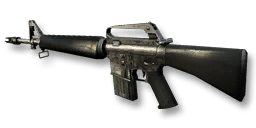
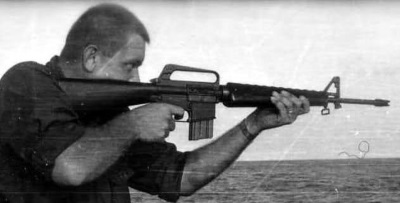
Image source: US Navy personnel training with the Model 604 in Vietnam, Pullig.com
The M16, specifically Colt's Model 604, is one of the earliest military versions of the AR-15 platform, designed in the late 50s as a variation of the 7.62mm AR-10 rifle downsized for the .223 Remington cartridge, differing mainly in use of a charging handle moved behind and below the carry handle rather than occupying the space inside the handle like on the later FAMAS. The 604 is the first AR-15 variation sold to the US military, where it was initially adopted by the Air Force as the M16 around 1963. Compared to the prior standard M14, it had some advantages, such as smaller ammunition which was fired at higher velocities to allow for similar levels of power, and a recoil buffer tube in the stock to reduce recoil - apparently a common thing drill instructors did to demonstrate this was bracing the stock against a trainee's balls and pulling the trigger. The lighter ammo also meant more of it could be carried for the same weight. However, several design decisions conspired to make the weapon a poor choice for the jungles of Vietnam where it first saw real service. Some of the issues were accidental - the only way to clear a jammed rifle was by near-complete disassembly (I read a story once about a Marine platoon that lost 53 of its 72 men in one fight, and when they came to check the dead, nearly every one of them had their rifles disassembled from trying to clear jams), and its direct-impingement gas system meant that some of the gases from firing a round were forced directly into the receiver to push against the bolt to operate the action, which didn't combo well with an eleventh-hour switch in the ammo itself to a type of gunpowder that burned far dirtier than the rifle was designed to handle. Other issues were intentional sabotage by people in Army Ordnance who wanted to go back to the M14, such as refusing to issue cleaning kits or train soldiers in basic maintenance and even falsely advertising the weapon as "self-cleaning" (and as a note, when efforts to reverse this were finally enacted, the maintenance manuals issued were illustrated by comics legend Will Eisner), as well as a story about the Army Ordnance board suggesting 117 improvements to the weapon - all of them rejected on the basis that, if they were necessary, Stoner and Sullivan would have included them from the beginning (and ignoring Stoner and Sullivan when they immediately began insisting they were - or even that some of them, like a chrome-plated bore, were already in the initial design, but then cut to save costs). The political slapfight revolving around the M16 ultimately lead to two versions of the weapon among the different branches, the Air Force using the Model 604 as the M16 while the other branches used the Model 603 as the XM16E1. The XM16E1 included improvements such as a forward assist which could be pressed to properly seat a bullet into the chamber; the Air Force initially refused this version because they thought the forward assist was an unnecessary cost addition, but this and the other improvements, such as chrome-plating the chamber and later the entire bore, and replacing the three-pronged duckbill flash hider with the now-familiar birdcage-style, cut down issues with the weapon just enough that it was standardized across every branch as the M16A1 between 1967 and 1969, remaining in production until 1982.
There's not a whole lot to say about it in-game that actually applies in singleplayer because, for one, it only really shows up two or three times despite the time frame (you'll quickly learn that this game really prefers the rare and exotic special forces-esque kit), and for two, as typical in this series, its singleplayer incarnation fires in full-auto rather than the three-round bursts it has in multi. Interestingly, in this game the singleplayer version is actually the accurate one (in as much as M16s with scopes attached to carry handles chopped down into a scope rail and M203 grenade launchers showing up in 1961 can be considered "accurate"), as the Model 604 was full-auto; burst-firing "Colt Commandos" were in use by SEALs since 1962, but full-sized AR-15s that could fire in bursts didn't hit the scene until the Model 645, adopted as the M16A2, came about around 1981.
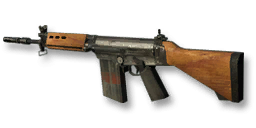
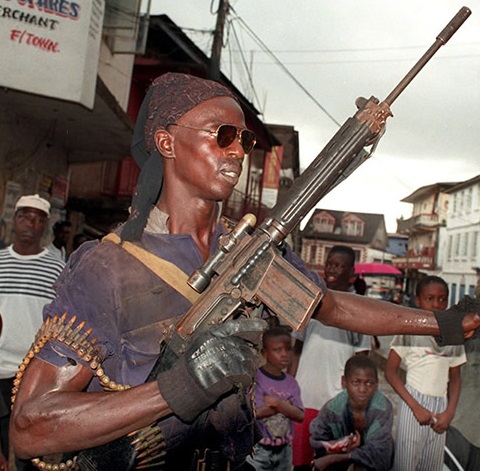
Image source: Liberian soldier directing foot traffic while holding a rusty scoped FAL, Guns.com
The enemy loadout so far is about what you'd expect, almost entirely Warsaw Pact in origin, though with one surprising inclusion in the FAL rifle. The "Fusil Automatique Léger" (light automatic rifle) began design immediately after WWII, designed by Dieudonné Saive (a protégé of legendary weapons designer John Moses Browning, already famous for finishing a design Browning had started on to make the Browning Hi-Power) and Ernest Vervier. Early prototypes went through various possible chamberings, the earliest models designed for the German 7.92x33mm cartridge used in the StG 44 and later prototypes from around 1948 chambered in the 7x43mm (.280 British) cartridge at Britain's urging, this design phase also seeing a single bullpup prototype before FN focused on the conventional layout. In 1950 the .280 version of the FAL and Britain's own domestic EM-2 rifle were tested in comparison to the United States' own efforts at a new post-war rifle, the T25 in .30 Light Rifle, and at America's urging they converted the FAL to the .30 Light Rifle cartridge, which ended up being adopted by NATO as the standard battle rifle cartridge, 7.62x51mm, in 1954.
The irony of the FAL showing up in Communist hands in this game is that it was known as the "Right Arm of the Free World" owing to the fact that every NATO member-state at least considering adopting it and all but three did (America, wanting to produce their own rifle, continued testing of the T25, eventually redesigning it into the T47 rifle which became the M14; West Germany was denied a license to produce it over their bad habit of steamrolling over Belgium twice in half a century, thus focusing on the Spanish CETME, upgrading it into the G3; and Italy simply didn't have the money to license it, instead focusing on local updates of their existing licensed M1 Garands, the BM59), so seeing it in WarPac hands is kind of like watching a WWI movie where the protagonist is an American soldier with a Luger rather than an M1911. The fun thing is this first instance in particular is actually the result of some rather sneaky research - about five-hundred of the guns were shipped into Cuba and adopted by the Cuban police, and they really were used during the Bay of Pigs invasion. Still, the game's only going to get weirder with who it hands them out to later on, even if I can appreciate getting a steady supply of them, since my personal favorite gun's only in one level (and later Black Ops games go out of their way to keep it out of my hands in any mode it'd be worth using in) but this thing that works very similarly shows up in every other level for about half the game.
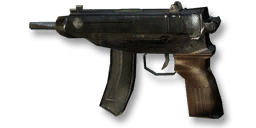
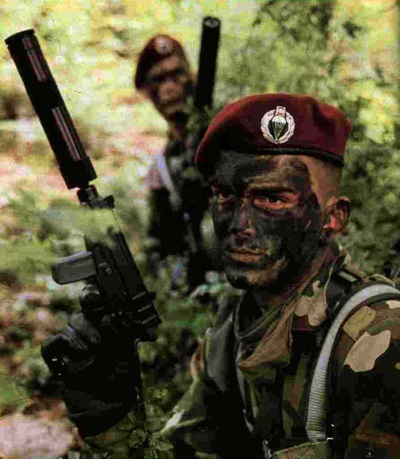
Image source: Serbian Special Operations Unit personnel with suppressed Škorpions, Guns.com
Another one of our first additions to the arsenal is the Škorpion vz. 61 machine pistol, possibly one of the first submachine guns designed to fire from a closed bolt, as opposed to the open-bolt operation most SMGs from WWII and before used; open-bolt designs are less mechanically complex, but less accurate owing to the fact that the bolt throws itself forward to chamber and fire a round in one motion after pulling the trigger, thus liable to interfere with the shooter's aim. It's also a little early to be showing up outside of Czechoslovakia, but hey. Originally developed for the .32 ACP cartridge, with other variants in various 9mm cartridges also designed but ultimately canned across the 60s; the original vz. 61 was eventually followed starting from the 80s with the vz. 82 in 9x18mm, the vz. 83 in .380 ACP, the modernized Sa. 361 in 9x19mm, and the semi-automatic CZ-91S in every caliber above. While the weapon is most famous in video games via the terminally-useless Klobb of classic GoldenEye infamy, Call of Duty has assigned it the opposite reputation, having a base damage high enough to kill in two or three shots at close range, depending on the game, and its introduction to the series in CoD4 including a glitch where the suppressor did not negatively impact that damage, which if you're the kind of person who hates yourself enough to play Hardcore mode like me made it an absolute terror that killed people in one shot without giving them a chance of figuring out where from. Even in later games in the series where it wasn't glitched into bending game balance over the nearest desk, it's still a fan-favorite for continuing to have that sort of high base damage and extremely low recoil, continuing to be more or less broken in other games (MW3 in particular broke it again by assigning machine pistols like it as secondary weapons, so you can pair it up with your near-instant-kill Type 95 or Mk 14).
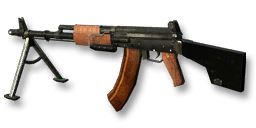
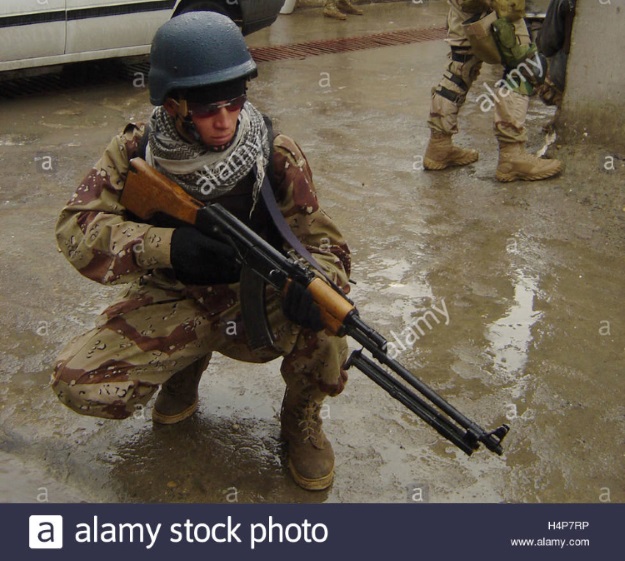
Image source: Stock photo of Iraqi soldier supporting American forces patrolling Mosul in November 2004, Alamy.com
Our last weapon that we get to see any sort of extensive use of for this mission is the RPK automatic rifle, one of the fifteen or so weapons directly derived from the AK. The original RPK was part of a standardization program to replace the RPD developed at the tail end of WWII; the primary design differences between the standard AK and the RPK are the longer barrel with an attached bipod, larger 40-round magazines and 75-round drums designed primarily for the RPK (though the inherent similarity in design between the two guns means the AK can take the RPK's extended mags), and an enlarged clubfoot-type stock with a hollowed compartment for storage of a cleaning kit. However, as this game will go out of its way to do, the actual model present is the RPK-74, a newer version designed for the down-sized 5.45x39mm bullets after the AK was similarly modified into the AK-74. Further differences between the original RPK and the -74 mirror many of the differences between the AK and AK-74, including another new type of magazine (45-round box mags; drums with a capacity of somewhere around 95 were tested but only issued in very limited quantities), an even longer and heavier barrel with chrome-plating, and steel inserts to reinforce the magazine well (if you can really call a hole in the bottom of the receiver a magazine well). The in-game model, when not using optical attachments, is further modified with an even more anachronistic Tech-SIGHT replacement top cover and rear sight, giving it a clearer sight picture for long-range shooting and, to this day, making me think for a second that they went all out on anachronism and put the fucking AK-12 in the game every time I see its pickup icon.
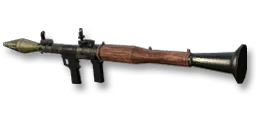
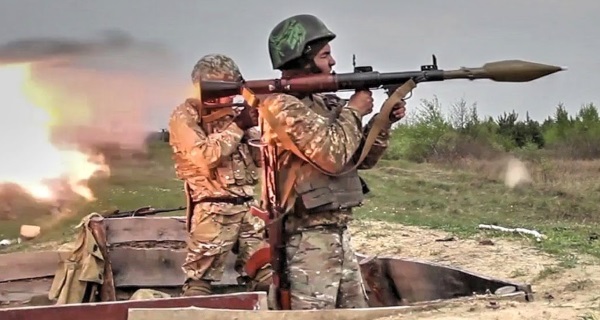
Image source: Youtube thumbnail of Ukrainian 1st Airmobile Battalion testing the RPG-7, AIIRSOURCE (video link)
I know I said the RPK was the last one, but... well, I'm never gonna use this thing again if I can help it, so I might as well talk about it here. The RPG-7, the most famous and prolific rocket-propelled grenade launcher. Otherwise known as the "Ruchnoy Protivotankovyy Granatomyot" (hand-held anti-tank grenade launcher), which also technically makes it, or earlier weapons similar to it, the originator of the "rocket-propelled grenade" term because of the initials matching up with that phrase*. A replacement for the post-war RPG-2 first used in 1961, mechanically it's basically an oversized single-shot revolver, including a lever behind the firing grip to recock the weapon after loading a new grenade (not that any games I'm aware of other than PAYDAY 2 have acknowledged it), with updated variants still in use today such as the RPG-7V2 for ground forces and the RPG-7D3 for paratroopers, both in use since 2001. However, similar to the reputation for the original AK, it's also one of the least accurate weapons of its type - a US Army evaluation in 1976 confirmed that, at 100 meters, the chance to hit a slow-moving, 2.5-by-5-meter panel was 96%, but at 200 it dropped to just above 50%... and that's assuming no crosswind, where winds moving as slow as three meters per second reduces the 50%-hit-probability range by twenty meters. It's even worse in these games, particularly in CoD4 where the rocket would all but ignore the laws of physics to veer off at ridiculous angles right before it was about to hit something near your target or that helicopter the enemy called in. I already hated this thing just from one or two attempts to use it when I first got a Call of Duty game, and trying to hit a moving target with the thing was one of the reasons my attempt at LPing CoD4 back in 2011 gave me video-game PTSD. I don't know if they made any significant attempts to make it better before Black Ops II (which had maps small enough I could simply get lucky) because I never even so much as touched the damn thing for five years; the only reason I could stand to pick it up now is because completely unrelated games like Killing Floor 2 finally made it a viable weapon for average joes rather than just the manliest of manly men.
*Also, for my sake, slap anyone that says a rocket-propelled chainsaw would be shortened to "RPB" rather than "RPC" in any case other than the first such device being created in Russia. Which, unless Russia is as obsessive over chainsaws as America is, probably isn't going to happen.
There was also a shotgun I skipped over, the KS-23, because as much as I like shotguns, Call of Duty is generally not the series to be using them in. Not very much of the fighting in the level, at least in places where I could guarantee I could keep the gun loaded, was geared towards it. Granted, the next level that straight-up hands one to you isn't much better, but there's still specific instances where you really want it, so I'm saving showing it off for then to make things easier on myself.
The Characters
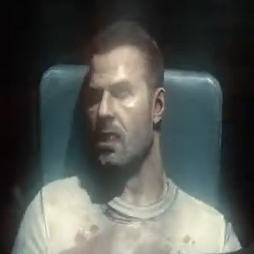
Alex Mason is our primary protagonist, a former Captain in the USMC Force Recon who served in the Korean War. Born on June 3rd of 1933, he's a fervent anti-Communist thanks to being born in Alaska, one of the closest places you could get to the USSR while still being in America. He's also an adept sniper thanks to spending his youth hunting elk and grizzly bears in the Alaskan wilderness with his father; according to his intel bio, he was the youngest winner of the Wimbledon Cup in 1953, at the age of 20. For the record, the winner from the real 1953 Wimbledon Cup - the first year in which restrictions were set on which rifle was allowed for the competition - was William Keith Turpie, who was about 29 at the time and, notably, managed to win without the use of Magnum cartridges in his weapon as had essentially become standard in the competition since Ben Comfort's use of a custom M1917 "US Enfield" in .300 H&H Magnum to win the 1935 Cup; I don't know who the real youngest Wimbledon Cup winner is because guns are bad and therefore Google has decided to focus entirely on the tennis Wimbledon Championship whenever I get more specific than "wimbledon cup" in searches, and while I do have a list of names for all the people who've won it I'll be damned if I'm wrestling Google to look up info on over 110 different people just to discover the majority of them don't even have listed dates of birth anywhere Google will bother to show me.
Mason is voiced by Sam Worthington, most famous for playing Joe in 2004's Somersault and Jake Sully in 2009's Avatar at the time this game came out. Since then he's had steady work, such as reprising his role of Perseus from Clash of the Titans in its 2012 sequel Wrath of the Titans, playing as Willem Holleeder in the 2015 Kidnapping Freddy Heineken (a crime drama based on a real case from 1983), an appearance in the "The Vet & The n00b" commercial for Modern Warfare 3 (in which he, as the voice of Mason, was "The Vet", paired up against Jonah Hill as "The Noob") and apparently plans to reprise his role as Jake Sully in two sequels to Avatar, both planned to be released in two parts across 2020 to 2025 because Hollywood law dictates you are absolutely not allowed to only make one sequel James Cameron apparently went completely fucking bonkers just trying to get the first one off the ground.
Also, as a note, Mason's father is noted as being a WWII vet who received the Purple Heart for being wounded in action at Makin Atoll. This is a reference to Treyarch's previous release in the series, World at War, where the first level was set on Makin and the player is wounded at the end. I'm pretty sure he's not supposed to be Mason-senior, though, considering that guy's last name was Miller.

Frank Woods is, to borrow a phrase from Lazyfire, our primary door-opener across the game. Another Marine, this time a Master Sergeant, born on March 20th, 1930 and having also seen combat in the Korean War, during which he apparently garnered the sort of reputation that saw the CIA seek him out for their Special Activities Division, which ultimately lead to where we are for today's mission. There's not a whole lot about him compared to Mason, so I'll go for this: he's sort of the Gaz-type character, the obligatory "cool guy" who manages to say just enough (and hint at enough psychopathy) that the percentage of the fanbase that realizes the game even has a singleplayer component latches onto him as the number-one representative of this section of the series. Yes, this means they pulled a complete bullshit retcon to bring him back for Black Ops II. Fortunately, by that point he's pushing a hundred years old, so for the actual gameplay there (outside of the flashback missions, which culminate in letting you play as him) and then in Black Ops III they went for a slightly more subtle "similar but different" approach for his character role and actually got new characters with new quirks to fill his role, instead of just straight-up putting a mask over him and giving him an incredibly unsubtle new nickname after some variety of poltergeist (or taking a redshirt who fucking knew the guy and turning him into a clone; I liked that mission but Jesus Christ that bit was fucking stupid).
Woods is voiced by James C. Burns, who surprisingly is actually best-known for this role. Other roles before and since include an uncredited appearance in the 2007 Transformers, an unnamed fraud consultant in a 2007 episode of CSI: NY, Jorhan Ryder Stahl in a 2008 episode of Burn Notice, an unnamed SWAT commander or generic cop in two episodes of Criminal Minds, and Dennis Logan in one episode of the new Hawaii Five-0.
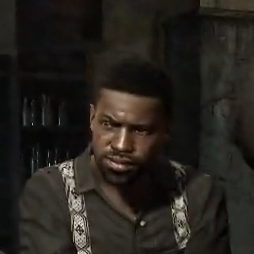
Joseph Bowman is a veteran of the US Navy, born on November 10th of 1940 and enlisting at age 17 to follow in his WWII veteran father's footsteps, scoring extremely high marks and passing the Underwater Demolition Team school. While there's only about as much about him as Woods so far, he's an interesting character in that he's also a door-opener, but for other NPCs. He and Woods work together frequently, but you can see even in this mission, they don't just hang together and do all the same things; for the most part any given mission they're involved in will have them split up into two groups, with Woods leading the player's group and Bowman leading the NPC group. And, surprisingly, they're not just cannon fodder to get killed so the player can step up to do whatever. I mean, they do still defer to you for a lot of the actual doing-things bits, but they don't do it because they all get killed and leave nobody but you to do it, they do it because
Bowman is voiced by O'Shea Jackson, Sr., better known by his stage name Ice Cube, a rapper and actor who, outside the world of music, is probably best known his role as Craig Jones in the 1995 comedy Friday, which he also produced. Other roles include as Danny Rich in the 1997 Anaconda, Chief Elgin in Three Kings from 1999, reprising his role as Craig Jones in 2000's Next Friday and 2002's Friday After Next, Darius Stone in xXx: State of the Union from 2005 (possibly the role to keep note of for his portrayal as Bowman), and James Payton in 2014's Ride Along and its 2016 sequel. As of this writing he's also working on reprising both that role for a third Ride Along and... Craig Jones in a fourth goddamned Friday film (this one thankfully named Last Friday so it should be the last one. Unless they mean "last" as in "previous" and it's a prequel for some reason).
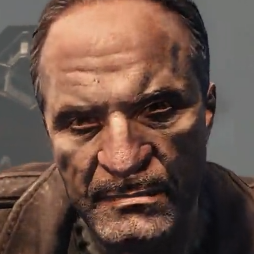
Nikita Dragovich, the crazy Russian named after dragons, is, as it turns out, our primary antagonist, a Major General in the Soviet military with some rather sinister plans in motion to bring the West to its knees. Not much is known about him at the time, so we'll keep things on the down-low for now. The most that can be said for now is that he was born on August 10th of 1914 in what is now Volgograd, and that he joined the Red Army and made General at some point before the siege in Stalingrad.
Dragovich's voice is Eamon Hunt, another actor who seems to be best known for his role in this game rather than anything before (or after) it. Other roles he's played include a "respectable guy" in the 1997 Men Behaving Badly, a guy named Dan in a single 1998 episode of the 1996-2007 7th Heaven, CPO Morris in a 2003 episode of NCIS, a patient who was injured in a play based on the Great Chicago Fire of 1871 in a 2005 episode of ER (his character played the cow that started the fire), Stephen Douglas in the 2013 Saving Lincoln, Jason Langly in Sharp from the same year, and a priest in a 2016 episode of Scorpion.
Intel
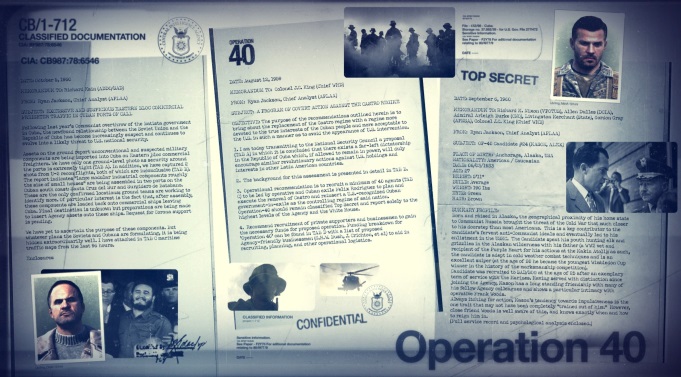
Click here to see the full 2724x1506 image
One thing I'm doing to set this apart from ye old Lazyfire LP is that I'm actually collecting the Intel. All of it. Appropriately, one of the things this game did to set its intel apart from that of Modern Warfare 2, where there was no reward other than an achievement for collecting it (and knowing the game never forced you to manipulate enemy spawns to access a pickup like CoD4 did, which I consider its own reward), is that you actually get to read the damned things after you pick them up. An "Intel" option in the campaign menu shows a set of documents for each level you've completed (generally three separate documents per level, though some mix it up and only have two or throw in a fourth), though they're almost entirely blacked-out at first. For each intel pickup you collect across the mission in question, about one-third of the documents' contents is decensored, eventually allowing you to read almost the entire document.
For our first mission the intel is all straightforward as it can get, all of it related to the Bay of Pigs invasion - a report on suspicious freighter activity in Cuba following the fall of the Batista government, a suggestion on recruitment for an "Operation 40" to overthrow Castro's regime without looking like a straight-forward US intervention, and a more in-depth dossier on Mason as a candidate for the operation.


















